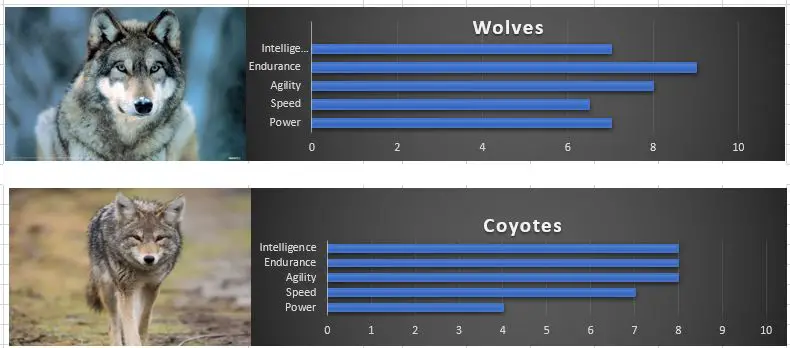Wolves are the top predator in North America, besides bears and humans, wolves do not eat coyotes as part of their main prey, but they often have to engage in fights because coyotes are scavengers that eat the leftovers of wolves.
The coyote is a carnivorous mammal of the Canidae family, to which the wolves also belong. They are found in the wild in North and Central America, where they share their territory with wolves.
Coyotes are on average less than 60 centimeters tall, between 74 and 94 centimeters long, and do not exceed 16 kilograms in weight.
Its bigger related is the gray wolf, which can reach a height of 90 cm and a length of more than 1.5 meters, weighing up to 80 kilograms.
With these great differences in size and power, there is not much a coyote can do when fighting a wolf, since it is a very unfair fight.
Wolves usually attack in packs, but even in a one-on-one fight, a wolf could overpower a coyote because of the great difference in power and size.
However, a coyote is also a fierce fighter that would not lose easily even if there is a difference in size.
In this topic, we analyze what are the qualities of both animals.

Power
Winner: Wolves
This is very obvious, the average adult wolf is almost twice the size of an adult coyote, in terms of power in a fight the first thing you look at is the size of the opponent.
Among the main attack weapon of both animals is their bite, the bite force coefficient of a gray wolf is 136, while that of a coyote is 88.
The bite force coefficient (BFQ) is the bite force of the animal in newtons divided by the mass of the body in kilograms.
For the coyote being a relatively small animal, it has a fairly strong and powerful bite, although not as strong as a domestic dog.
On the other hand, the wolf’s bite force coefficient is even higher than that of a tiger and a lion, obviously, tigers and lions are much heavier and have other offensive resources.
There is another way to measure the strength of a bite, this is the pound per square inch (PSI), it is estimated that the bite of a gray wolf on average can reach 800 PSI or more, much higher than most domestic dogs.
The coyote on the other hand can have a bite of 200 PSI on average, the difference between the bite of both animals is almost triple.
Speed
Winner: Coyotes
Wolves may be very fast and agile, but coyotes are faster than wolves, although the difference is not abysmal.
A wolf can run at an average speed of 50-60 km/h, while a coyote at 55-69 km/h, the coyote will need some time to develop full speed.
The difference in speed is so even that a coyote running in the snow could be overtaken by a wolf following at close range, for a coyote to escape from a wolf it must have some advantage in order to develop full speed.
Intelligence
Winner: Coyotes
Wolves have proven to be very intelligent animals in their hunting strategy, they know how to corner and coordinate attacks and their group work is exceptional.
But coyotes can work both in groups and in a coordinated manner, their social structure is as complicated as that of wolves.
Coyotes, being less gifted predators than wolves, have to rely more on their creativity and cunning, as well as being able to adapt to different environments, such as urban environments.
In a one-on-one fight the intelligence of the coyote would not be of much use against the wolf, but if we talk about survival the difference is notorious, a solitary coyote has more chances of surviving than a solitary coyote.
The wolf needs its pack to hunt successfully, the coyote is a scavenger and opportunist. Coyotes have survived for more than a century by adapting to and surviving even human predation, coyotes are considered masters of adaptation.
Endurance
Winner: Wolves
Although wolves are not known for their speed, they are known for their endurance, in fact, their hunting strategy consists of making their prey flee, chasing it, and cornering it for long distances.
This requires very high endurance, wolves can cover long distances in difficult terrain such as snow at about 8 km/h. Wolves are predators that hunt on the run so endurance is one of their main skills, wolves are among the best endurance animals on land.
Wolves can maintain 99% of their top speed for about 30 seconds, and 80% for a very long time.
The coyote is also very resistant, coyotes travel long distances, although they are not animals that hunt on the run like wolves, a coyote can travel between 2 and 5 km per day, but it is possible that it can travel up to 40 km in a day, that is why they have been able to expand throughout the Americas.
Concluding remarks
Wolves are exceptional animals, almost mythical, their fame is known worldwide, a coyote would not stand a chance in a fight against a wolf, I think the chances would be a pack of coyotes against a single wolf and even then it is very difficult for the coyotes to win.
Anyway, I think that coyotes are very underestimated animals, the great adaptation of the coyote and its intelligence have made it an animal that could survive easier than a wolf, the coyote can adapt more easily to any environment.
It may not be a great hunter, but its ability as a scavenger gives it the ability to obtain varied and more abundant food.
Resources:
https://www.scientificamerican.com/article/coyotes-are-the-new-top-dogs/











































